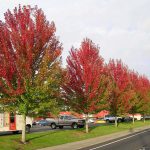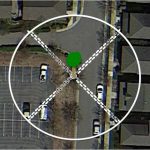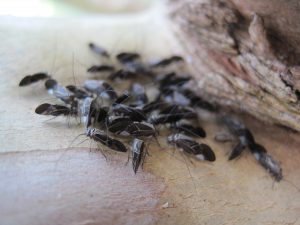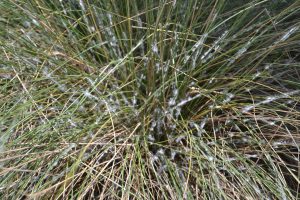The “Pace to Plant” technique is a tool to quickly and accurately quantify the amount of impervious surface surrounding a tree or planting site. Begin by standing at the planting site and identify the closest impervious surface edge. Take 25 steps at 45⁰ to the nearest impervious edge, counting only the steps that land on the impervious surface. Then, return to the identified planting site and begin walking 25 steps in the opposite direction. Again, only count the steps that fall onto impervious surface. If you encounter a building or wall, count the remainder of the steps as impervious. One more time, return to the starting planting site. This time turn 90° and begin walking 25 steps and count the steps that fall onto impervious surface. Finally, turn around and go back to the planting site and begin walking in the opposite direction for 25 steps. This will be the fourth time that steps falling onto the impervious surface are counted. Having walked in four directions located 90° from each other, completing an “X” through the planting site, the transect is final with a total of 100 steps have been taken. By totaling the number of steps that fall onto impervious surfaces the percentage of the surrounding ground area can be determined. For example, if the total number of steps falling on impervious surface is 65 (out of the potentially 100 steps), the percentage of impervious surface is 65%. Using the established criteria, the site would not be suitable for planting a Red Maple.
Growing Healthy Palms Workshop

University of Florida palm and disease Extension specialist Dr. Monica
Elliott will share information on palm installation and best management
practices.
- Timing and techniques for proper palm planting.
Establishing and care for palms through proper watering,
fertilization, and pruning. - Learn the cold hardy palms to plant along the Gulf Coast and
palm issues and diseases associated with cold weather
injury. - Where to focus your palm care when funds are limited.
Wednesday July 27, 2016
Pensacola (10-11:45am), Escambia County Central Office Complex, 3363 West Park Place Pensacola, FL 32505
REGISTER: Program is free but register for a spot by calling 475-5230 or emailing bbolles@ufl.edu
Santa Rosa Beach (3-4:45pm), Walton County Extension Annex 70 Logan Ln, Santa Rosa Beach, FL 32459
REGISTER: Program is free but register by calling 850-892-8172 or emailing haneyc@ufl.edu
CEUs to be available
Cattle Grazing on My Trees…
Cattle aren’t really grazing on the trees (this time), but tree cattle (a.k.a. bark lice) are grazing on the trees. The scientific name for tree cattle is Cerastipsocus venosus. Adults have shiny black wings that are held at a sharp angle resembling an old style camping tent or an F-117 Nighthalk stealth fighter. Wingless adults also exist.
The nymphs have an ovate abdomen with dark gray and light yellow banding similar to a honeybee. A related species, Archipsocus nomas, is known to produce unharmful webbing that covers the trunk and branches of trees, but not the leaves.
These insects are usually seen in a colony containing a mixture of nymphs and adults. Unlike hair lice, bark lice are not parasites and are classified as beneficial insects. Unlike most beneficial insects, they do not feed on other insects. Instead, they clean the bark by eating excess accumulations of fungi, algae, lichens, dead bark, and other nonliving material. Tree cattle are not bark borers and do not eat leaves or living bark.
They are often seen on crape myrtles, but have been reported to graze on oaks and Bradford pears. Bark lice are more prevalent during hot and humid summer months.
Tree cattle are classified as beneficial, therefore no management is required. Because clientele may consider the term beneficial insect to be an oxymoron, it is important to supply supplemental educational materials to back up your claim. Publications are available from Clemson University and Auburn University.

It is time to monitor for Rose Rosette Disease in Florida
Author: Dr. Mathews Paret
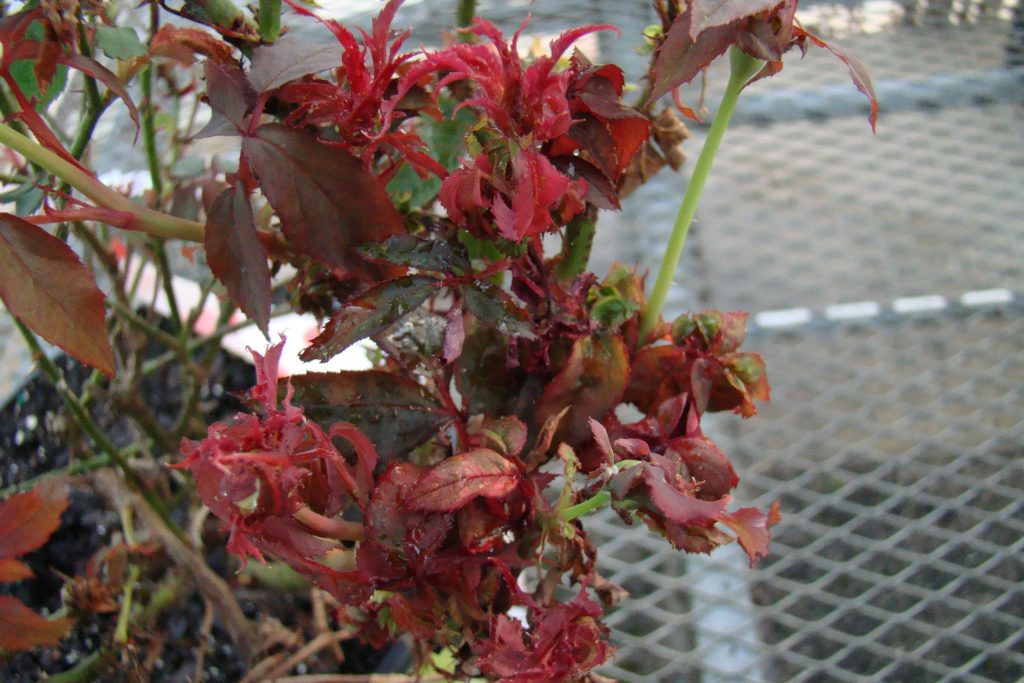
Rose Rosette (Photo Credits: Mathews Paret)
Caused by: Rose rosette virus (Currently not present in Florida; but previously discovered in three counties in Florida in 2013 and 2014 led to the successful destroyal of the infected plants)
Vectored by: An eriophyid mite species; Phyllocoptes fructiphilus (Not known to be present in Florida). Grafting or budding can also transmit the virus from infected to healthy plants
Why is monitoring for rose rosette disease in Florida important?
- Currently, Florida is the state with the largest value in wholesale production of roses in the U.S ($29.7 million)
- The landscaping industry in Florida heavily uses roses and especially shrub roses.
- The disease can affect all varieties of roses
- Currently, there is no known cure for Rose Rosette Disease, and hence early detection and eradication of infected plants is the key to prevent any establishment of the disease in Florida
Thus, monitor and report to the county extension agent or University of Florida, Plant Pathology Lab at NFREC, Quincy if suspicious plants are noted. This is critical in ensuring that Florida roses are well protected this year and in the coming years from Rose Rosette Disease.
Symptoms of the disease and details of the virus can be found in the following documents.
Rose Rosette Disease: A new disease of roses in Florida
http://edis.ifas.ufl.edu/pdffiles/PP/PP31700.pdf
IFAS Pest Alert: Rose Rosette Virus
http://programs.ifas.ufl.edu/u-scout/Alert_files/RRV_PestAlert_Paret_2014.pdf
Relevant information on all major diseases of roses in Florida can be also found at U-scout website of NFREC, University of Florida
http://programs.ifas.ufl.edu/u-scout/Rose/Rose.html
Contact person:
Mathews Paret
Assistant Professor, Plant Pathology
University of Florida, NFREC, University of Florida paret@ufl.edu, 850-875-7154
Muhly Grass Pest
Muhly grass (Muhlenbergia capillaris) is a generally pest free plant in our area, however, we are seeing the native mealybug, Stemmatomerinx acircula, on plants in various landscapes. Insects are on the leaves and are grey with white wax that may have some filaments. You may also see long ovisacs on the leaves which contain eggs and crawlers. The native fakahatchee grass may also be a host.
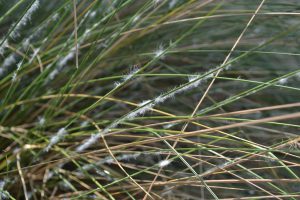
The mealybug is white with fine filaments and numerous mealybugs can be found each leaf. Photo: Beth Bolles
The common practice of right plant, right place does not always prevent the mealybug infestations on muhly grass. Specimens in both full and shade can be affected, as well as mass plantings and those spaced out. At this time, there is not a lot of information on why some plantings are heavily infested and others are not.
Since mealybugs are piercing sucking insects, there may be some browning of leaves, especially on less vigorous plants. You may have to remove and destroy plants that are heavily infested and declining. In situations where treatment is warranted you may choose a systemic insecticide or oil spray to keep plants looking more attractive. As the landscape manager, you will need to decide what is an acceptable threshold for this pest.
Limited Urban Commercial Fertilizer License – Do You Have It?
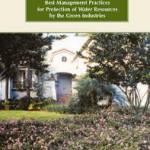 On June 18, 2009, Florida Governor Charlie Crist signed into law SB 494 requiring all commercial fertilizer applicators have a license by January 1, 2014. Passing the Green Industries Best Management Practices (GI-BMP) training is mandatory to obtain that license. University of Florida/IFAS Extension provides training and testing programs in urban landscape management practices and issues certificates demonstrating satisfactory completion of the training. These classes are available in English, Spanish, or Haitian Creole.
On June 18, 2009, Florida Governor Charlie Crist signed into law SB 494 requiring all commercial fertilizer applicators have a license by January 1, 2014. Passing the Green Industries Best Management Practices (GI-BMP) training is mandatory to obtain that license. University of Florida/IFAS Extension provides training and testing programs in urban landscape management practices and issues certificates demonstrating satisfactory completion of the training. These classes are available in English, Spanish, or Haitian Creole.
After receiving a certificate of completion of the GI-BMP training, a person must pay $25 and apply with Florida Department of Agriculture and Consumer Services (FDACS) to receive the Limited Certification for Urban Landscape Commercial Fertilizer (LCULCF) also commonly called the “fertilizer license.” You can apply online or download the paper application and apply by mail.
There has been a lot of confusion over which certificate is needed by the applicator. Many individuals have not completed the second step of the process and are not in compliance with current state laws. If you are unsure which certification you hold, check your wallet card for the identification number; an FDACS issued certification will begin with “LF” and the GI-BMP certification begins with “GV.” You must have the FDACS certification beginning with “LF” to apply fertilizer for-hire.
The LCULCF certification expires 4 years after the date of issuance. Continuing education of two hours of F.S. 482 General Standards CORE and two hours of the category Limited Urban Fertilizer are required for renewal. Those that received their LCULCF certification before the 2014 deadline may be approaching the need for renewal.
The good news is, if you passed the GI-BMP certification but failed to take the next step towards FDACS certification your GI-BMP training certificate is non-expiring and you can still apply for the LCULCF without attending the training again. Not sure if you have successfully completed this program? You can check here the list of certificate holders by county at http://ffl.ifas.ufl.edu/professionals/certification_lists/cert_county_name.shtml.
If you did pass the course, but cannot locate your GI-BMP certificate, you can request a replacement copy here.
Using UF/IFAS-recommended application rates and timing of pesticides, fertilizer and irrigation can help prevent nonpoint source pollution (water pollution that is associated with everyday human activities and driven by rainfall, runoff and leaching) from urban landscapes. By choosing plants appropriate for the site and maintaining them with correct cultural practices (irrigation, fertilization, mowing and pruning), one can significantly reduce the amount of water a landscape needs to thrive.
The GI-BMP class teaches landscape workers how to implement these Best Management Practices into their daily work. This is an opportunity for Green Industry workers to complete this requirement and market their skills to clientele. Trainings are available monthly across the Panhandle as well as on-line. Visit the website for more information http://fyn.ifas.ufl.edu/professionals/BMP_overview.htm.
